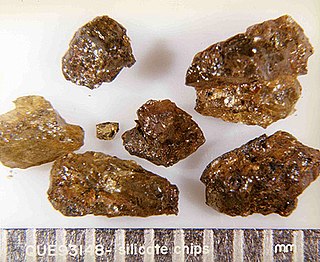
A chondrule is a round grain found in a chondrite. Chondrules form as molten or partially molten droplets in space before being accreted to their parent asteroids. Because chondrites represent one of the oldest solid materials within the Solar System and are believed to be the building blocks of the planetary system, it follows that an understanding of the formation of chondrules is important to understand the initial development of the planetary system.

A chondrite is a stony (non-metallic) meteorite that has not been modified, by either melting or differentiation of the parent body. They are formed when various types of dust and small grains in the early Solar System accreted to form primitive asteroids. Some such bodies that are captured in the planet’s gravity well become the most common type of meteorite by arriving on a trajectory toward the planet’s surface. Estimates for their contribution to the total meteorite population vary between 85.7% and 86.2%.

An achondrite is a stony meteorite that does not contain chondrules. It consists of material similar to terrestrial basalts or plutonic rocks and has been differentiated and reprocessed to a lesser or greater degree due to melting and recrystallization on or within meteorite parent bodies. As a result, achondrites have distinct textures and mineralogies indicative of igneous processes.

Iron meteorites, also known as siderites, or ferrous meteorites, are a type of meteorite that consist overwhelmingly of an iron–nickel alloy known as meteoric iron that usually consists of two mineral phases: kamacite and taenite. Most iron meteorites originate from cores of planetesimals, with the exception of the IIE iron meteorite group

The LL chondrites are a group of stony meteorites, the least abundant group of the ordinary chondrites, accounting for about 10–11% of observed ordinary-chondrite falls and 8–9% of all meteorite falls. The ordinary chondrites are thought to have originated from three parent asteroids, with the fragments making up the H chondrite, L chondrite and LL chondrite groups respectively. The composition of the Chelyabinsk meteorite is that of a LL chondrite meteorite. The material makeup of Itokawa, the asteroid visited by the Hayabusa spacecraft which landed on it and brought particles back to Earth also proved to be type LL chondrite.

Primitive achondrites are a subdivision of meteorites. They are classified on the same rank and lying between chondrites and achondrites. They are called primitive because they are achondrites that have retained much of their original chondritic properties. Very characteristic are relic chondrules and chemical compositions close to the composition of chondrites. These observations are explained as melt residues, partial melting, or extensive recrystallization.

Lodranites are a small group of primitive achondrite meteorites that consists of meteoric iron and silicate minerals. Olivine and pyroxene make up most of the silicate minerals. Like all primitive achondrites lodranites share similarities with chondrites and achondrites.
Winonaites are a group of primitive achondrite meteorites. Like all primitive achondrites, winonaites share similarities with chondrites and achondrites. They show signs of metamorphism, partial melting, brecciation and relic chondrules. Their chemical and mineralogical composition lies between H and E chondrites.

Acapulcoites are a group of the primitive achondrite class of stony meteorites.

IAB meteorites are a group of iron meteorites according to their overall composition and a group of primitive achondrites because of silicate inclusions that show a strong affinity to winonaites and chondrites.

IIICD meteorites are a group of primitive achondrites. They are classified in a clan together with the IAB meteorites and the winonaites.

Brachinites are a group of meteorites that are classified either as primitive achondrites or as asteroidal achondrites. Like all primitive achondrites, they have similarities with chondrites and achondrites. Brachinites contain 74 to 98% (Volume) olivine.

The Zakłodzie meteorite is a stony-iron meteorite found in Poland in 1998. Its mass is 8.68 kilograms (19.1 lb). It is composed predominantly from enstatite and meteoric iron. Currently classified as an ungrouped enstatite achondrite its classification is still an ongoing scientific debate.
The Itqiy meteorite is an enstatite-rich stony-iron meteorite. It is classified as an enstatite chondrite of the EH group that was nearly melted and is therefore very unusual for that group. Other classifications have been proposed and are an ongoing scientific debate.
The Vermillion meteorite is a pallasite (stony-iron) meteorite and one of two members of the pyroxene pallasite grouplet.
The pyroxene pallasite grouplet is a subdivision of the pallasite meteorites (stony-irons).

Stony-iron meteorites or siderolites are meteorites that consist of nearly equal parts of meteoric iron and silicates. This distinguishes them from the stony meteorites, that are mostly silicates, and the iron meteorites, that are mostly meteoric iron.
The Winona meteorite is a primitive achondrite meteorite. It is the type specimen and by far the largest meteorite of the winonaite group.

Nonmagmatic meteorite is a deprecated term formerly used in meteoritics to describe iron meteorites that were originally thought to have not formed by igneous processes, to differentiate them from the magmatic meteorites, produced by the crystallization of a metal melt. The concept behind this was developed in the 1970s, but it was quickly realized that igneous processes actually play a vital role in the formation of the so-called "nonmagmatic" meteorites. Today, the terms are still sometimes used, but usage is discouraged because of the ambiguous meanings of the terms magmatic and nonmagmatic. The meteorites that were described to be nonmagmatic are now understood to be the product of partial melting and impact events and are grouped with the primitive achondrites and the achondrites.
This is a glossary of terms used in meteoritics, the science of meteorites.













